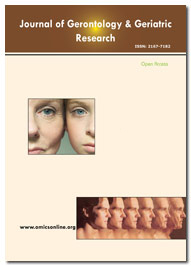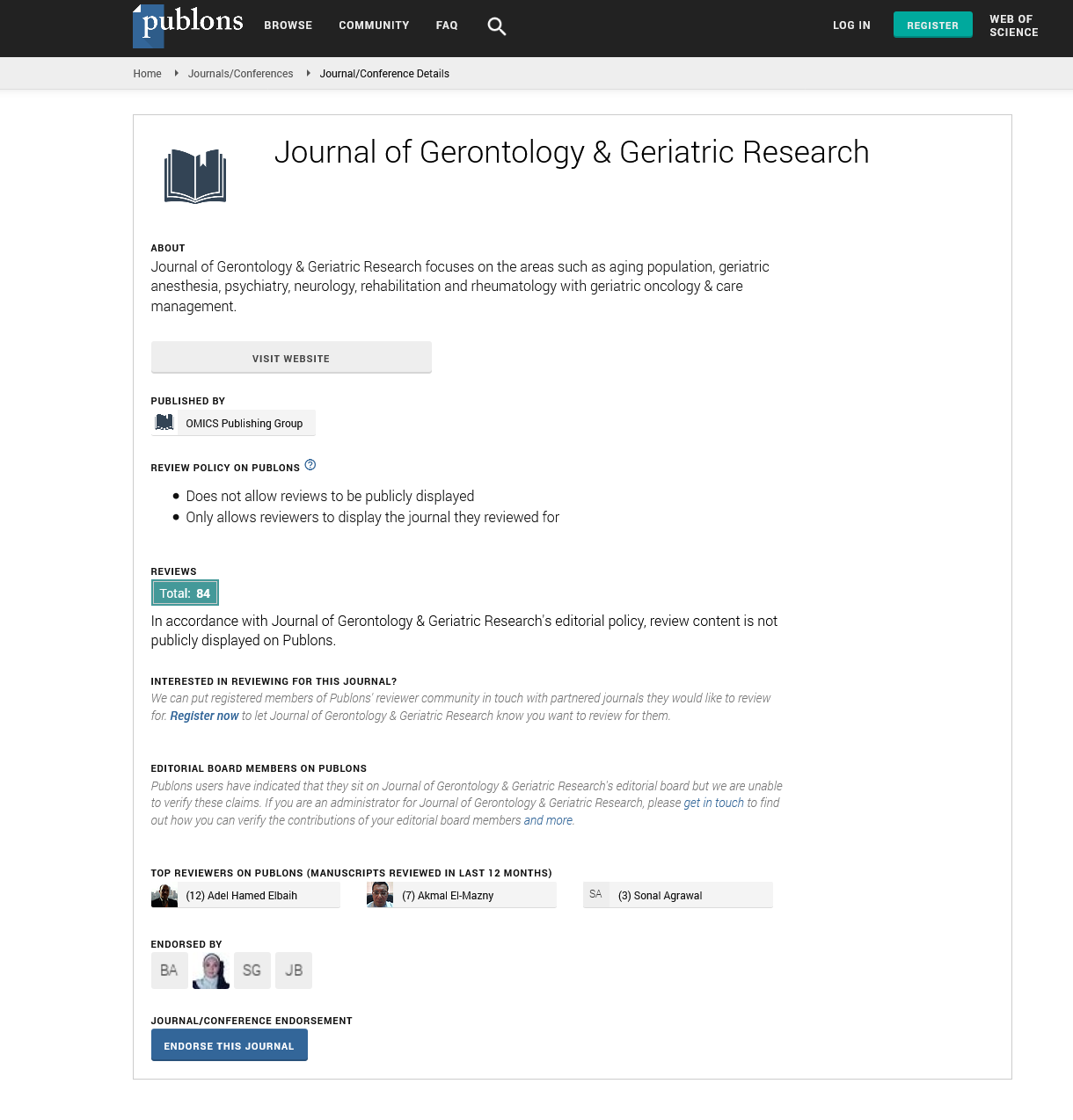Indexed In
- Open J Gate
- Genamics JournalSeek
- SafetyLit
- RefSeek
- Hamdard University
- EBSCO A-Z
- OCLC- WorldCat
- Publons
- Geneva Foundation for Medical Education and Research
- Euro Pub
- Google Scholar
Useful Links
Share This Page
Journal Flyer

Open Access Journals
- Agri and Aquaculture
- Biochemistry
- Bioinformatics & Systems Biology
- Business & Management
- Chemistry
- Clinical Sciences
- Engineering
- Food & Nutrition
- General Science
- Genetics & Molecular Biology
- Immunology & Microbiology
- Medical Sciences
- Neuroscience & Psychology
- Nursing & Health Care
- Pharmaceutical Sciences
Commentary - (2024) Volume 13, Issue 3
Improving Mobility in Older Adults Advances in Geriatric Physical Therapy
Tim Chung*Received: 01-Jun-2024, Manuscript No. jggr-24-27517; Editor assigned: 03-Jun-2024, Pre QC No. P-27517; Reviewed: 15-Jun-2024, QC No. Q-27517; Revised: 21-Jun-2024, Manuscript No. R-27517; Published: 28-Jun-2024, DOI: 10.35248/2167-7182.2024.13.734
Introduction
As populations age, the need for effective interventions to enhance mobility in older adults becomes increasingly critical. Geriatric physical therapy plays a vital role in improving mobility, reducing fall risk, and enhancing overall quality of life for this demographic. This review article examines recent advances in geriatric physical therapy, highlighting innovative strategies, evidence-based practices, and emerging technologies that support mobility improvement in older adults. Mobility is a fundamental aspect of independence and quality of life for older adults. However, age-related physiological changes, chronic conditions, and environmental factors can impede mobility, leading to increased dependence and diminished well-being. Geriatric physical therapy aims to address these challenges through targeted interventions that promote movement, balance, and strength. This review explores the latest advancements in geriatric physical therapy that are shaping the future of mobility enhancement for older adults. Mobility encompasses a range of activities, from walking and climbing stairs to the ability to perform daily tasks. Independence Mobility allows older adults to engage in daily activities without relying on caregivers. Physical Health Regular movement helps combat the effects of aging, including muscle atrophy and cardiovascular decline [1].
Mental well-being active individuals tend to have better mental health outcomes, including reduced depression and anxiety. Social engagement mobility facilitates social interactions, which are vital for emotional support and cognitive health. Despite its importance, many older adults face mobility challenges due to factors such as frailty, joint pain, and neurological conditions. Addressing these challenges requires innovative approaches in geriatric physical therapy. Recent research has underscored the importance of evidence-based practices in geriatric physical therapy. Clinicians are increasingly utilizing protocols backed by scientific studies to optimize mobility outcomes. Strength training progressive resistance training has been shown to improve strength, functionality, and mobility in older adults. Research indicates that even small increases in muscle strength can significantly enhance balance and reduce fall risk [2].
Description
Balance training programs incorporating balance exercises, such as tai chi, have been effective in improving postural stability and reducing falls. These interventions are particularly beneficial for frail older adults. Aerobic exercise engaging in regular aerobic activities, such as walking or cycling enhances cardiovascular fitness and endurance, which are essential for maintaining mobility. The integration of technology in geriatric physical therapy has led to innovative solutions for mobility enhancement. Wearable devices wearable technology, such as accelerometers and smart watches, can monitor activity levels, providing valuable data for therapists. These devices can also offer real-time feedback to encourage adherence to exercise programs [3].
Tele health services have expanded access to physical therapy, particularly for older adults with mobility issues. Virtual therapy sessions allow therapists to guide patients through exercises and monitor progress from the comfort of their homes. Robotics and Exoskeletons Robotic devices and exoskeletons are being explored for their potential to assist individuals with severe mobility impairments. These technologies can aid in rehabilitation and improve functional mobility [4]. A multidisciplinary approach is essential for addressing the complex needs of older adults. Collaborations between physical therapists, occupational therapists, geriatricians, and social workers can lead to comprehensive care plans that address mobility issues holistically. Comprehensive Assessments Thorough evaluations that assess physical, cognitive, and emotional health are vital for creating personalized intervention plans. Educating patients and caregivers about mobility issues, fall prevention strategies, and the importance of exercise foster a supportive environment for recovery and maintenance of mobility.
Community-based programs that promote physical activity and social engagement can be instrumental in supporting older adults' mobility. These programs often leverage local resources to provide exercise classes, walking groups, and health education [5]. Innovative exercise programs tailored to older adults have emerged as effective tools for improving mobility. Some of these programs include Dance Therapy Dance-based interventions, such as zumba gold or ballroom dancing; provide a fun and engaging way to improve strength, flexibility, and coordination while promoting social interaction.
Conclusion
Future directions for improving mobility in older adults through geriatric physical therapy include Personalized Medicine Utilizing genetic and biomarker research to tailor interventions to individual needs and responses may enhance treatment efficacy. Longitudinal Studies More long-term studies are needed to evaluate the lasting impacts of various interventions on mobility and overall health in older adults. Policy Advocacy Advocating for policies that promote access to geriatric care and physical therapy services is essential for ensuring that older adults receive the support they need. Improving mobility in older adults is a multifaceted challenge that requires innovative solutions and a holistic approach. Advances in geriatric physical therapy, including evidence-based interventions, technology integration, and multidisciplinary collaboration, are essential for addressing the mobility needs of this population. By continuing to explore and implement effective strategies, we can enhance the quality of life for older adults and support their desire for independence and active living.
Acknowledgement
None.
Conflict of Interest
None.
References
- Colón-Emeric CS, Whitson HE, Pavon J, Hoenig H. Functional decline in older adults. Am Fam Physician. 2013;88:388.
- Tieland M, Trouwborst I, Clark BC. Skeletal muscle performance and ageing. J Cachexia Sarcopenia Muscle. 2018;9:3-19.
- Osoba MY, Rao AK, Agrawal SK, Lalwani AK. Balance and gait in the elderly: A contemporary review. Laryngoscope Investig Otolaryngo. 2019;4:143-153.
- Kasović M, Štefan L, Štefan A. Normative data for gait speed and height norm speed in≥ 60-year-old men and women. Clin Interv Aging. 202:225-230.
- Callisaya ML, Launay CP, Srikanth VK, Verghese J, Allali G, Beauchet O. Cognitive status, fast walking speed and walking speed reserve—the Gait and Alzheimer Interactions Tracking (GAIT) study. Geroscience. 2017;39:231-239.
Google Scholar, Crossref, Indexed at
Google Scholar, Crossref, Indexed at
Google Scholar, Crossref, Indexed at
Citation: Chung T (2024). Improving Mobility in Older Adults Advances in Geriatric Physical Therapy. J Gerontol Geriatr Res. 13: 734.
Copyright: © 2024 Chung T. This is an open-access article distributed under the terms of the Creative Commons Attribution License, which permits unrestricted use, distribution, and reproduction in any medium, provided the original author and source are credited.

